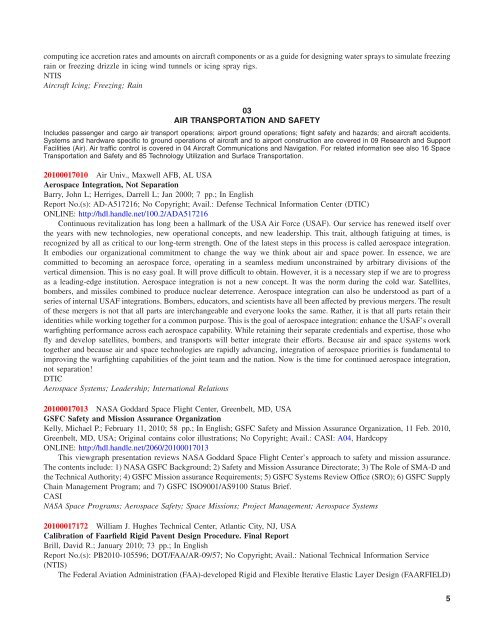NASA Scientific and Technical Aerospace Reports - The University ...
NASA Scientific and Technical Aerospace Reports - The University ...
NASA Scientific and Technical Aerospace Reports - The University ...
You also want an ePaper? Increase the reach of your titles
YUMPU automatically turns print PDFs into web optimized ePapers that Google loves.
computing ice accretion rates <strong>and</strong> amounts on aircraft components or as a guide for designing water sprays to simulate freezing<br />
rain or freezing drizzle in icing wind tunnels or icing spray rigs.<br />
NTIS<br />
Aircraft Icing; Freezing; Rain<br />
03<br />
AIR TRANSPORTATION AND SAFETY<br />
Includes passenger <strong>and</strong> cargo air transport operations; airport ground operations; flight safety <strong>and</strong> hazards; <strong>and</strong> aircraft accidents.<br />
Systems <strong>and</strong> hardware specific to ground operations of aircraft <strong>and</strong> to airport construction are covered in 09 Research <strong>and</strong> Support<br />
Facilities (Air). Air traffic control is covered in 04 Aircraft Communications <strong>and</strong> Navigation. For related information see also 16 Space<br />
Transportation <strong>and</strong> Safety <strong>and</strong> 85 Technology Utilization <strong>and</strong> Surface Transportation.<br />
20100017010 Air Univ., Maxwell AFB, AL USA<br />
<strong>Aerospace</strong> Integration, Not Separation<br />
Barry, John L; Herriges, Darrell L; Jan 2000; 7 pp.; In English<br />
Report No.(s): AD-A517216; No Copyright; Avail.: Defense <strong>Technical</strong> Information Center (DTIC)<br />
ONLINE: http://hdl.h<strong>and</strong>le.net/100.2/ADA517216<br />
Continuous revitalization has long been a hallmark of the USA Air Force (USAF). Our service has renewed itself over<br />
the years with new technologies, new operational concepts, <strong>and</strong> new leadership. This trait, although fatiguing at times, is<br />
recognized by all as critical to our long-term strength. One of the latest steps in this process is called aerospace integration.<br />
It embodies our organizational commitment to change the way we think about air <strong>and</strong> space power. In essence, we are<br />
committed to becoming an aerospace force, operating in a seamless medium unconstrained by arbitrary divisions of the<br />
vertical dimension. This is no easy goal. It will prove difficult to obtain. However, it is a necessary step if we are to progress<br />
as a leading-edge institution. <strong>Aerospace</strong> integration is not a new concept. It was the norm during the cold war. Satellites,<br />
bombers, <strong>and</strong> missiles combined to produce nuclear deterrence. <strong>Aerospace</strong> integration can also be understood as part of a<br />
series of internal USAF integrations. Bombers, educators, <strong>and</strong> scientists have all been affected by previous mergers. <strong>The</strong> result<br />
of these mergers is not that all parts are interchangeable <strong>and</strong> everyone looks the same. Rather, it is that all parts retain their<br />
identities while working together for a common purpose. This is the goal of aerospace integration: enhance the USAF’s overall<br />
warfighting performance across each aerospace capability. While retaining their separate credentials <strong>and</strong> expertise, those who<br />
fly <strong>and</strong> develop satellites, bombers, <strong>and</strong> transports will better integrate their efforts. Because air <strong>and</strong> space systems work<br />
together <strong>and</strong> because air <strong>and</strong> space technologies are rapidly advancing, integration of aerospace priorities is fundamental to<br />
improving the warfighting capabilities of the joint team <strong>and</strong> the nation. Now is the time for continued aerospace integration,<br />
not separation!<br />
DTIC<br />
<strong>Aerospace</strong> Systems; Leadership; International Relations<br />
20100017013 <strong>NASA</strong> Goddard Space Flight Center, Greenbelt, MD, USA<br />
GSFC Safety <strong>and</strong> Mission Assurance Organization<br />
Kelly, Michael P.; February 11, 2010; 58 pp.; In English; GSFC Safety <strong>and</strong> Mission Assurance Organization, 11 Feb. 2010,<br />
Greenbelt, MD, USA; Original contains color illustrations; No Copyright; Avail.: CASI: A04, Hardcopy<br />
ONLINE: http://hdl.h<strong>and</strong>le.net/2060/20100017013<br />
This viewgraph presentation reviews <strong>NASA</strong> Goddard Space Flight Center’s approach to safety <strong>and</strong> mission assurance.<br />
<strong>The</strong> contents include: 1) <strong>NASA</strong> GSFC Background; 2) Safety <strong>and</strong> Mission Assurance Directorate; 3) <strong>The</strong> Role of SMA-D <strong>and</strong><br />
the <strong>Technical</strong> Authority; 4) GSFC Mission assurance Requirements; 5) GSFC Systems Review Office (SRO); 6) GSFC Supply<br />
Chain Management Program; <strong>and</strong> 7) GSFC ISO9001/AS9100 Status Brief.<br />
CASI<br />
<strong>NASA</strong> Space Programs; <strong>Aerospace</strong> Safety; Space Missions; Project Management; <strong>Aerospace</strong> Systems<br />
20100017172 William J. Hughes <strong>Technical</strong> Center, Atlantic City, NJ, USA<br />
Calibration of Faarfield Rigid Pavent Design Procedure. Final Report<br />
Brill, David R.; January 2010; 73 pp.; In English<br />
Report No.(s): PB2010-105596; DOT/FAA/AR-09/57; No Copyright; Avail.: National <strong>Technical</strong> Information Service<br />
(NTIS)<br />
<strong>The</strong> Federal Aviation Administration (FAA)-developed Rigid <strong>and</strong> Flexible Iterative Elastic Layer Design (FAARFIELD)<br />
5

















